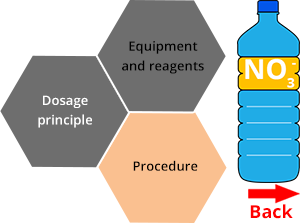Analysis of a spring water
Determination of NO3- ions by colorimetric titration
Procedure
Determination of a sample:
Insert into a 100 mL high-neck beaker, in this order:
- Glass beads
- 10 mL Sample
- 1 mL of sodium salicylate solution.
Evaporate until the mixture is dry, without calcination, to an anhydrous state. This is done by heating in a microwave oven. It will be preferable to extend the heating time rather than increase the temperature (about 80°C).
Leave to cool down.
Under the hood, add 2 mL of concentrated sulfuric acid (96%) to each beaker.
Wait 10 min and stir occasionally to reconstitute the residue.
Add 15 mL of milli-Q quality water under the hood, with extreme caution (risk of splashing).
Slowly pour 15 mL of the tartrate solution into the sodium hydroxide under the hood, with extreme caution again (risk of splashes + exothermic reaction). The yellow color appears.
Leave to cool down for about 15 mins in a cooling bath (cover if necessary).
Perform the spectrophotometric measurements at 415 nm after setting the unit to zero absorbance using the deionized water as a sample.
Blank test:
Perform a blank test by replacing the test sample with distilled water.
Calibration
It is necessary to plot a calibration curve with standard solutions of known nitrite concentrations. In a series of 50 mL volumetric flasks, prepare aqueous NO3- solutions of concentrations: 0; 0.5; 1; 2.5; 5; 7.5; 10; 12.5; 15 mg.L-1.
Once prepared, proceed exactly as for a water sample.
 ≈ 60 minutes / sample
≈ 60 minutes / sample





